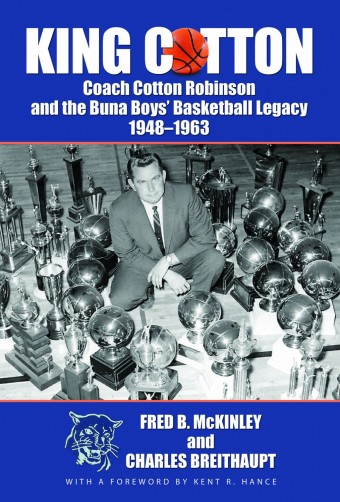Breithaupt Co-authors Book on Buna Basketball Legend, Cotton Robinson
By Jeanne Acton, UIL Journalism Director | Tuesday, December 06, 2011 7:25 AM

A draft of the cover of the book.
King Cotton: Coach Cotton Robinson and the Buna Boys’ Basketball Legacy, 1948-1963.
“I’ve been writing this book in my head for the past 20 years,” said UIL Executive Director and co-author of the book, Charles Breithaupt.
It makes sense.
Breithaupt grew up in Buna during the era of Coach Cotton Robinson.
“Since elementary school, I idolized him,” he said. “Anyone who grew up in the town did.”
And why wouldn’t they? Coach Robinson revolutionized the game of basketball in Texas. He won seven state titles, which is still a record today, and made infamous the “double-post offense” originally designed by Clemit Hyden, the Buna girls’ basketball coach.
“For many years, people asked me about chronicling the life of Coach Robinson,” Breithaupt said.
Another Buna graduate, Fred McKinley, heard the same thing.
“Finally, we decided we had enough material and enough interest so we found a publisher,” Breithaupt said.
The two have been researching and collaborating since January to put together this 302-page book that details the life of Coach Cotton, a basketball icon, who created one of the most-used offenses to date, the “Buna offense.”
“The Buna Offense is still being used today — 50 years later,” Breithaupt said. “I was watching the Final Four last year, and the ESPN commentator was talking about a team that was utilizing the Buna Offense.”
Coach Robinson only coached at Buna High School for 15 years, but in that time he made a lasting impact on the town and the game of basketball.
“He was such a pioneer,” Breithaupt said “The lessons he taught — they are still here today. He coached hard, and his kids respected him. He had a great deal of self-discipline and confidence.
“Back then, you didn’t see much full court press defense. He came out with a defensive philosophy that pressed all over the court. And he perfected the Buna Offense, which is all about spacing, precision and patience.”
Breithaupt said one sports writer described Coach Robinson like this: if you gave Coach Robinson five players and five timeouts, he could beat anyone.
While Breithaupt was lucky enough to know Coach Robinson and his family who lived right around the corner from him, he was not lucky enough to have played for him.
“I played for his assistant,” he said. “We were the worst team in the history of the school, though it was not his fault.”
Coach Robinson retired at age 38 and went into the insurance business.
“He said he was worn out from the pressure to keep up the high standards,” he said. “But he was developing stomach cancer at that time. He knew something was wrong.”
In 1986 at the age of 61, Coach Robinson died from the cancer.
To write the book, Breithaupt and McKinley used material they had kept over the years, researched family archives and interviewed past players, coaches, sports writers and more.
“We found out several interesting things,” Breithaupt said. “Coach Robinson was a guy who grew up in the country. He went to Leona High School and played basketball at that very small school. During high school he played in the UIL State Tournament in 1943 and even was on the All-State Tournament team.”
One of the most ironic discoveries happened one summer when Coach Robinson went back to college to work on his master’s degree.
“He took a course called Coaching Basketball,” he said. “When we looked at his transcript, we had to laugh. Here was one of the best high school coaches ever and he got a B in Coaching Basketball.”
Breithaupt said some coaches who have multiple state championships have large egos.
“But Coach Robinson didn’t,” he said. “He was so humble. He attributed his success to the parents, to his players, to the school district, anyone but himself. He led such a conservative life in such a conservative time, but he was so innovative in the way he coached.”
While talking to former players Breithaupt said he was struck by how successful so many of his players were after high school, and not just in basketball but also in life.
“They all attribute their success to him — to the lessons he taught them as their coach,” he said.
The book begins with an overview of the history of the town, the school and Robinson’s upbringing. Then, it jumps to 1948, Coach Robinson’s first season. The book is filled with vintage photos and vignettes showing different aspects of Coach Robinson, both the man and coach.
In the press release for the book, Eric Angevine, a college basketball insider at ESPN.com, said, “Cotton Robinson’s blend of inspiration, teamwork, preparation and persistence provided a clear road map to success for his players both on and off the hardwood. Thanks to Fred McKinley and Charles Breithaupt, contemporary basketball fans can today glean similar wisdom from the late, great coach. The story of his life is told with such detail and warmth, you’ll feel like you were there.”
Breithaupt said while writing the book was time-consuming and meant a lot of late nights, he enjoyed the experience — both the writing and walking down memory lane.
“I was able to remember things from elementary school — some of those great times,” he said. “It was such a simpler time in life.”
Now that he’s completed his first book, Breithaupt said he foresees more publications in his future. He would love to write a young adult book like one of his childhood favorite authors John Tunis.
“His books inspired,” Breithaupt said. “I see so little of that now. I would love to do something like that next.”
King Cotton, published by Eakin Press, will be released in the first quarter of 2012.







